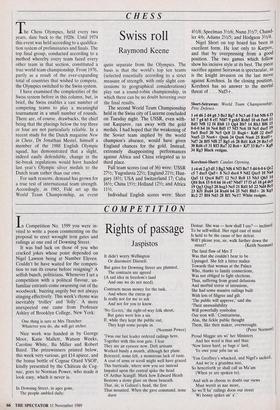CHESS
Swiss roll
Raymond Keene
The Chess Olympics, held every two years, date back to the 1920s. Until 1974 this event was held according to a qualifica- tion system of preliminaries and finals. The top final group, conducted according to a method whereby every team faced every other team in that section, constituted a true world team championship. From 1976, partly as a result of the ever-expanding total of countries that wished to compete, the Olympics switched to the Swiss system.
I have examined the complexities of the Swiss system before in this column, but, in brief, the Swiss enables a vast number of competing teams to play a meaningful tournament in a small number of rounds. There are, of course, drawbacks, the chief being that the placings below the top three or four are not particularly reliable. In a recent study for the Dutch magazine New in Chess, Dr Jonathan Mestel, himself a member of the 1988 English Olympic squad, has demonstrated that a slight, indeed easily defendable, change in the tie-break regulations would have handed last year's Olympic silver medals to the Dutch team rather than our own.
For such reasons, demand has grown for a true test of international team strength. Accordingly, in 1985, Fide set up the World Team Championship, an event quite separate from the Olympics. The basis is that the world's top ten teams (selected essentially according to a strict measure of strength, with only slight con- cessions to geographical considerations) play out a round-robin championship, in which there can be no doubt hovering over the final results.
The second World Team Championship held in the Swiss city of Lucerne concluded on Tuesday night. The USSR, even with- out Kasparov, ran away with the gold medals. I had hoped that the weakening of the Soviet team implied by the world champion's absence, would have given England chances for the gold. Instead, extremely disappointing performances against Africa and China relegated us to third place.
Full team scores (out of 36) were: USSR 271/2; Yugoslavia 221/2; England 211/2; Hun- gary 181/2; USA and Switzerland 17; Cuba 161/2; China 151/2; Holland 121/2; and Africa 111/2.
Individual English scores were: Short
41/2/8; Speelman 31/2/6; Nunn 31/2/7; Chand- ler 4/6; Adams 21/2/5; and Hodgson 31/2/4.
Nigel Short on top board has been in excellent form. He lost only to Karpov, and that by overpressing from a good position. The two games which follow show his incisive style at its hest. The piece sacrifice against Seirawan is spectacular, as is the knight invasion on the last move against Korchnoi. In the closing position, Korchnoi has no answer to the mortal threat of . . . Nxf3+.
Short-Seirawan: World Team Championship; Piric Defence.
1 e4 d6 2 d4 g6 3 Be3 Bg7 4 Nc3 a6 5 h4 Nf6 6 13 b5 7 g4 h5 8 e5! Nfd7 9 gxh5 RxhS 10 e6 fxe6 11 Bd3 NM 12 14 Rh8 13 Qg4 Bb7 14 Rh3 B16 15 0-0-0 b4 16 Ne4 Bd5 17 Nf3 Nc6 18 Ne5 dxe5 19 fxe5 BxeS 20 Nc5 Oa 21 Bxg6+ Kd8 22 dxe5 Nxe5 23 Nxe6+ Qxe6 24 Qxe6 Nxe6 25 RxdS+ Nd7 26 Bf5 Nf8 27 Bg5 c6 28 Rdl Ke8 29 Re3 e5 30 Rd6 c5 31 Rf3 Raj 32 Re6+ Kt'? 33 Re7+
34 Rg3 Black resigns.
Korchnoi-Short: Catalan Opening.
1 c4 e6 2 g3 d5 3 Bg2 Nf6 4 Nf3 Be7 d4 0-0 6 Qc2 c5 7 dxc5 Qa5+ 8 Nc3 dxc4 9 Nd2 QxcS 10 Na4 Qa5 11 Qxc4 Bd7! 12 Nc3 Rc8 13 Nb3 Qh5 14 Qf4 Bc6 15 0-0 h6 16 e4? Nbd7 17 f3 a5 18 g4 de5 19 Qg3 Qxg3 20 hxg3 Ne5 21 Rdl b5 22 Nd4 Bc5 23 Kfl Bxd4 24 Rxd4 b4 25 Ndl BbS+ 26 Kgl Rc2 27 Bf4 Nd3 28 Bfl Nell! White resigns.










































































 Previous page
Previous page